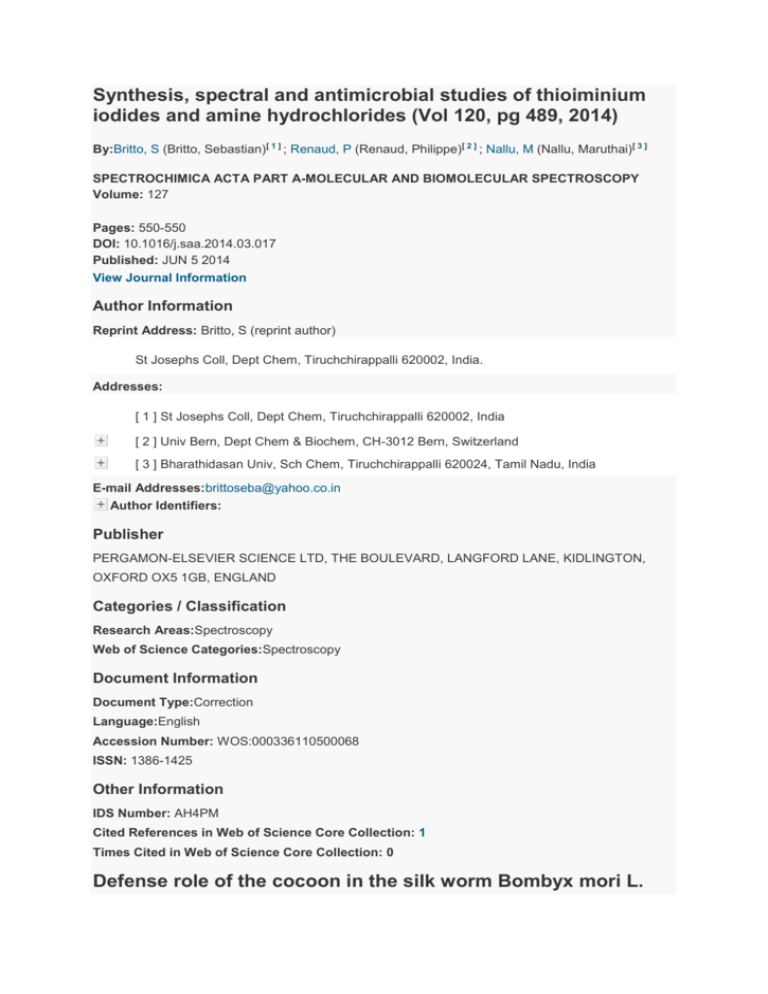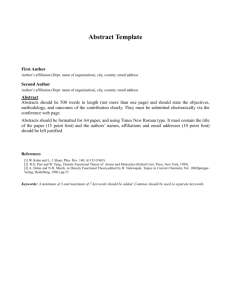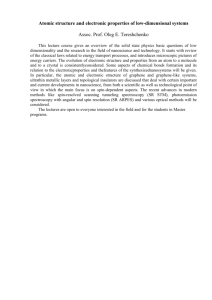
Synthesis, spectral and antimicrobial studies of thioiminium
iodides and amine hydrochlorides (Vol 120, pg 489, 2014)
By:Britto, S (Britto, Sebastian)[ 1 ] ; Renaud, P (Renaud, Philippe)[ 2 ] ; Nallu, M (Nallu, Maruthai)[ 3 ]
SPECTROCHIMICA ACTA PART A-MOLECULAR AND BIOMOLECULAR SPECTROSCOPY
Volume: 127
Pages: 550-550
DOI: 10.1016/j.saa.2014.03.017
Published: JUN 5 2014
View Journal Information
Author Information
Reprint Address: Britto, S (reprint author)
St Josephs Coll, Dept Chem, Tiruchchirappalli 620002, India.
Addresses:
[ 1 ] St Josephs Coll, Dept Chem, Tiruchchirappalli 620002, India
[ 2 ] Univ Bern, Dept Chem & Biochem, CH-3012 Bern, Switzerland
[ 3 ] Bharathidasan Univ, Sch Chem, Tiruchchirappalli 620024, Tamil Nadu, India
E-mail Addresses:brittoseba@yahoo.co.in
Author Identifiers:
Publisher
PERGAMON-ELSEVIER SCIENCE LTD, THE BOULEVARD, LANGFORD LANE, KIDLINGTON,
OXFORD OX5 1GB, ENGLAND
Categories / Classification
Research Areas:Spectroscopy
Web of Science Categories:Spectroscopy
Document Information
Document Type:Correction
Language:English
Accession Number: WOS:000336110500068
ISSN: 1386-1425
Other Information
IDS Number: AH4PM
Cited References in Web of Science Core Collection: 1
Times Cited in Web of Science Core Collection: 0
Defense role of the cocoon in the silk worm Bombyx mori L.
By:Pandiarajan, J (Pandiarajan, Jeyaraj)[ 1 ] ; Cathrin, BP (Cathrin, Britto P.)[ 1 ] ; Pratheep,
T (Pratheep, Thangaraj)[ 1 ] ; Krishnan, M (Krishnan, Muthukalingan)[ 1 ]
RAPID COMMUNICATIONS IN MASS SPECTROMETRY
Volume: 25
Issue: 21
Pages: 3203-3206
DOI: 10.1002/rcm.5213
Published: NOV 15 2011
View Journal Information
Abstract
Silk from the domesticated silk worm Bombyx mori procures foreign body response naturally, so it has
been utilized as a biomaterial for decades. In India the prime focus of the sericulture industry is to
improve silk production with high quality silk. Naturally, the silk worm builds its cocoon not only with
silk proteins, but also with antimicrobial proteins to avoid infection since the cocoon is non-motile and
non-feeding. The aim of the present study is to elucidate the antimicrobial proteins that persist in the
cocoon of the silk worm Bombyx mori. At the pupal stage, the silk worm cocoon shell extract was
prepared from the day of pupation (P0) to the day of natural rupture of the cocoon for the eclosion of
moth (NR). Using the cocoon shell extract a microbial susceptibility test was performed by the disc
diffusion method against the microbes Escherchia coli, Bacillus cereus, Staphylococcus aureus,
Pseudomonas aeruginosa, and Klebsiella pneumoniae. The development of a zone of inhibition
against the microbes confirmed the presence of antimicrobial/immunogenic activity of the cocoon
shell extract. For further analysis, the cocoon shell extract was subjected to 7-15% sodium dodecyl
sulfate/polyacrylamide gel electrophoresis (SDS-PAGE). The protein profile of the cocoon extract
revealed the coomassie blue stained bands resolved from the 150 - 15 kDa molecular range.
Interestingly, a polypeptide localized at around 29 kDa showed remarkable expressional changes
during the development of pupa. To characterize the 29 kDa protein, it was eluted from the gel,
digested with trypsin and analyzed by matrix-assisted laser desorption/ionization mass spectrometry
(MALDI-MS). The trypsin-digested peptide peaks were analyzed through MASCOT and peptides were
matched with the NCBI nr database. The peptides were very well matched with the 18 wheeler
protein, which is reported to be responsible for innate immunity, belonging to the Toll family in insects
and responsible for cellular mediated immunity. Copyright (C) 2011 John Wiley & Sons, Ltd.
Keywords
KeyWords Plus:DROSOPHILA TOLL PROTEIN; GENE; FAMILY; MEMBER; 18WHEELER; INSECTS
Author Information
Reprint Address: Krishnan, M (reprint author)
Bharathidasan Univ, Insect Mol Biol Lab, Dept Environm Biotechnol, Sch Environm Sci, Tiruchchirappalli 620024
Addresses:
[ 1 ] Bharathidasan Univ, Insect Mol Biol Lab, Dept Environm Biotechnol, Sch Environm Sci, Tiruchchirappalli 620
E-mail Addresses:profmkrish@yahoo.com
Funding
Funding Agency
UGC
Grant Number
F.4-3/2006 (BSR) 11-73/2008/BSR
View funding text
Publisher
WILEY-BLACKWELL, COMMERCE PLACE, 350 MAIN ST, MALDEN 02148, MA USA
Categories / Classification
Research Areas:Biochemistry & Molecular Biology; Chemistry; Spectroscopy
Web of Science Categories:Biochemical Research Methods; Chemistry, Analytical; Spectroscopy
Document Information
Document Type:Article
Language:English
Accession Number: WOS:000296428600002
PubMed ID: 22006381
ISSN: 0951-4198
Other Information
IDS Number: 840GY
Cited References in Web of Science Core Collection: 24
Times Cited in Web of Science Core Collection: 6
Using mass spectrometry to detect buffalo salivary odorantbinding protein and its post-translational modifications
By:Rajkumar, R (Rajkumar, R.)[ 1,2,5 ] ; Karthikeyan, K (Karthikeyan, K.)[ 1 ] ; Archunan, G (Archunan,
G.)[ 1 ] ; Huang, PH (Huang, P. H.)[ 2 ] ; Chen, YW(Chen, Y. W.)[ 3,4 ] ; Ng, WV (Ng, W. V.)[ 6 ] ; Liao,
CC (Liao, C. C.)[ 2 ]
RAPID COMMUNICATIONS IN MASS SPECTROMETRY
Volume: 24
Issue: 22
Pages: 3248-3254
DOI: 10.1002/rcm.4766
Published: NOV 2010
View Journal Information
Abstract
A large number of mammalian odorant-binding proteins, which are lipocalins, have been studied.
These proteins participate in pen-receptor events by selecting and carrying odorant molecules. The
present study aimed at identifying the buffalo salivary odorant-binding protein (sOBP), and to
determine its post-translational modification using mass spectrometry. The buffalo salivary 21 kDa
protein was initially separated adopting sodium dodecyl sulfate-polyacrylamide gel electrophoresis
and it was identified as sOBP with high statistical reliability using liquid chromatography/tandem mass
spectrometry (LC/MS/MS) and SEQUEST, for the first time. Further, the post-translationally modified
peptides were screened adopting MS/MS. A total of four post-translational modifications, namely
glycation at lysine-(59), hydroxylation at lysine-(134), ubiquitination at lysine-(121), and
dihydroxylation in lysine-(108), were recorded. Moreover, these modifications have not been identified
in buffalo salivary odorant-binding protein. Copyright (C) 2010 John Wiley & Sons, Ltd.
Keywords
KeyWords Plus:AMINO-ACID-SEQUENCE; PHEROMONEBINDING; BOVINE; CLONING; COMMUNICATION; PURIFICATION; PATHWAY; FLEHMEN;LIGAN
D; ESTRUS
Author Information
Reprint Address: Archunan, G (reprint author)
Bharathidasan Univ, Dept Anim Sci, Ctr Pheromone Technol, Tiruchchirappalli 620024, Tamil Nadu, India.
Addresses:
[ 1 ] Bharathidasan Univ, Dept Anim Sci, Ctr Pheromone Technol, Tiruchchirappalli 620024, Tamil Nadu, India
[ 2 ] Natl Yang Ming Univ, Prote Res Ctr, Taipei 112, Taiwan
[ 3 ] Natl Tsing Hua Univ, Coll Life Sci, Dept Life Sci, Hsinchu 30013, Taiwan
[ 4 ] Natl Tsing Hua Univ, Coll Life Sci, Inst Bioinformat & Struct Biol, Hsinchu 30013, Taiwan
[ 5 ] City Univ Hong Kong, Dept Biol & Chem, Prote Core Facil, Hong Kong, Hong Kong, Peoples R China
[ 6 ] Natl Yang Ming Univ, Inst Biotechnol Med, Taipei 112, Taiwan
E-mail Addresses:archunan@bdu.ac.in; ccliao@ym.edu.tw
Funding
Funding Agency
Grant Number
DBT
UGC-SAP, Government of India
National Science Council of Taiwan
View funding text
Publisher
JOHN WILEY & SONS LTD, THE ATRIUM, SOUTHERN GATE, CHICHESTER PO19 8SQ, W
SUSSEX, ENGLAND
Categories / Classification
Research Areas:Biochemistry & Molecular Biology; Chemistry; Spectroscopy
Web of Science Categories:Biochemical Research Methods; Chemistry, Analytical; Spectroscopy
Document Information
Document Type:Article
Language:English
Accession Number: WOS:000284023400004
PubMed ID: 20972998
ISSN: 0951-4198
Other Information
IDS Number: 677VZ
Cited References in Web of Science Core Collection: 42
Times Cited in Web of Science Core Collection: 9
Detection of alpha(2u)-globulin and its bound putative
pheromones in the preputial gland of the Indian commensal rat
(Rattus rattus) using mass spectrometry
By:Rajkumar, R (Rajkumar, R.)[ 1,2 ] ; Ilayaraja, R (Ilayaraja, R.)[ 1 ] ; Liao, CC (Liao, C. C.)[ 2 ] ; Archunan, G (Archunan, G.)[ 1 ] ; Achiraman, S (Achiraman, S.)[ 3 ] ; Prakash, S (Prakash,
S.)[ 5 ] ; Ng, WV (Ng, W. V.)[ 4 ] ; Tsay, YG (Tsay, Y. G.)[ 2 ]
RAPID COMMUNICATIONS IN MASS SPECTROMETRY
Volume: 24
Issue: 6
Pages: 721-728
DOI: 10.1002/rcm.4437
Published: MAR 2010
View Journal Information
Abstract
The role of pheromones and pheromone-binding proteins in the laboratory rat has been extensively
investigated. However, we have previously reported that the preputial gland of the Indian commensal
rat produces a variety of pheromonal molecules and preputial glands would seem to be the
predominant source for pheromonal communication. The presence of pheromone-binding proteins
has not yet been identified in the preputial gland of the Indian commensal rat; therefore, the
experiments were designed to unravel the alpha(2u)-globulin (alpha 2u) and its bound volatiles in the
commensal rat. Total preputial glandular proteins were first fractionated by sodium dodecyl
sulfate/polyacrylamide gel electrophoresis (SDS-PAGE) and subsequently analyzed by mass
spectrometry. Further, we purified alpha 2u and screened for the presence of bound pheromonal
molecules with the aid of gas chromatography/mass spectrometry (GC/MS). A novel alpha 2u was
identified with a high score and this protein has not been previously described as present in the
preputial gland of Indian commensal rats. This novel alpha 2u was then characterized by tandem
mass spectrometry (MS/MS). Peptides with m/z values of 969, 1192, 1303 and 1876 were further
fragmented with the aid of MS/MS and generated de novo sequences which provided additional
evidence for the presence of alpha 2u in the preputial gland. Finally, we identified the presence of
farnesol 1 and 2 bound to alpha 2u. The present investigation confirms the presence of alpha 2u
(18.54 kDa) in the preputial gland of the Indian commensal rat and identifies farnesol 1 and 2 as
probably involved in chemo-communication by the Indian commensal rat. Copyright (C) 2010 John
Wiley & Sons, Ltd.
Keywords
KeyWords Plus:MICE
Author Information
Reprint Address: Archunan, G (reprint author)
Bharathidasan Univ, Dept Anim Sci, Ctr Pheromone Technol, Tiruchchirappalli 620024, Tamil Nadu, India.
Addresses:
[ 1 ] Bharathidasan Univ, Dept Anim Sci, Ctr Pheromone Technol, Tiruchchirappalli 620024, Tamil Nadu, India
[ 2 ] Natl Yang Ming Univ, Prote Res Ctr, Inst Biochem & Mol Biol, Taipei 112, Taiwan
[ 3 ] Bharathidasan Univ, Dept Environm Biotechnol, Tiruchchirappalli 620024, Tamil Nadu, India
[ 4 ] Natl Yang Ming Univ, Inst Biotechnol Med, Taipei 112, Taiwan
[ 5 ] Indian Inst Sci, Dept Biochem, Mol Biophys Unit, Bangalore 560012, Karnataka, India
E-mail Addresses:archunan@bdu.ac.in
Funding
Funding Agency
Grant Number
Commonwealth Commission, UK
Heiwa Nakajima Foundation, Japan
UGC
UGC-SAP
DST-FIST, Government of India
View funding text
Publisher
WILEY-BLACKWELL, COMMERCE PLACE, 350 MAIN ST, MALDEN 02148, MA USA
Categories / Classification
Research Areas:Biochemistry & Molecular Biology; Chemistry; Spectroscopy
Web of Science Categories:Biochemical Research Methods; Chemistry, Analytical; Spectroscopy
Document Information
Document Type:Article
Language:English
Accession Number: WOS:000276111100003
PubMed ID: 20169559
ISSN: 0951-4198
Other Information
IDS Number: 575YX
Cited References in Web of Science Core Collection: 41
Times Cited in Web of Science Core Collection: 3
Cyanobacterial chlorophyll as a sensitizer for colloidal TiO2
By:Kathiravan, A (Kathiravan, A.)[ 1 ] ; Chandramohan, M (Chandramohan, M.)[ 2 ] ; Renganathan,
R (Renganathan, R.)[ 1 ] ; Sekar, S (Sekar, S.)[ 2 ]
SPECTROCHIMICA ACTA PART A-MOLECULAR AND BIOMOLECULAR SPECTROSCOPY
Volume: 71
Issue: 5
Pages: 1783-1787
DOI: 10.1016/j.saa.2008.06.031
Published: JAN 2009
View Journal Information
Abstract
Chlorophyll has been extracted from cyanobacteria. The adsorption of chlorophyll on the surface of
colloidal TiO2 through electrostatic interaction was observed. The apparent association constant
(K,,p) of chlorophyll-TiO2 obtained from absorption spectra is 3.78 x 10(4) M-1. The K-app value of
chlorophyll-TiO2 as determined from fluorescence spectra is 1.81 x 10(4) M-1, which matches well
with that determined from the absorption spectra changes. These data indicate that there is an
interaction between chlorophyll and colloidal TiO2 nanoparticle surface. The dynamics of
photoinduced electron transfer from chlorophyll to the conduction band of colloidal TiO2 nanoparticle
has been observed and the mechanism of electron transfer has been confirmed by the calculation of
free energy change (Delta G(et)) by applying Rehm-Weller equation as well as energy level diagram.
Lifetime measurements gave the rate constant (k(et)) for electron injection from the excited state
chlorophyll into the conduction band of TiO2 is 4.2 x 10(8) s(-1). (C) 2008 Elsevier B.V. All rights
reserved.
Keywords
Author Keywords:TiO2 colloid; Fluorescence quenching; Chlorophyll
KeyWords Plus:PHOTOINDUCED INTERACTION; ELECTRON-TRANSFER; PARTICULATE
SYSTEMS; PHOTO-SENSITIZATION; FLASH-PHOTOLYSIS; PHOTOSYSTEM-II; HYPOCRELLINB; CYANINE DYE; PHOTOSENSITIZATION; SEMICONDUCTOR
Author Information
Reprint Address: Renganathan, R (reprint author)
Bharathidasan Univ, Sch Chem, Tiruchchirappalli 620024, India.
Addresses:
[ 1 ] Bharathidasan Univ, Sch Chem, Tiruchchirappalli 620024, India
[ 2 ] Bharathidasan Univ, Dept Biotechnol, Tiruchchirappalli 620024, India
E-mail Addresses:rrengas@gmail.com
Funding
Funding Agency
Grant Number
01(2217)/08/EMR-11
CSIR, Government of India
dt.06/05/2008
Department of Science and Technology, New Delhi, Government of India
View funding text
Publisher
PERGAMON-ELSEVIER SCIENCE LTD, THE BOULEVARD, LANGFORD LANE, KIDLINGTON,
OXFORD OX5 1GB, ENGLAND
Categories / Classification
Research Areas:Spectroscopy
Web of Science Categories:Spectroscopy
Document Information
Document Type:Article
Language:English
Accession Number: WOS:000261900000026
PubMed ID: 18678524
ISSN: 1386-1425
Other Information
IDS Number: 386RJ
Cited References in Web of Science Core Collection: 33
Times Cited in Web of Science Core Collection: 9
An investigation on electron transfer quenching of zinc(II)
meso-tetraphenylporphyrin (ZnTPP) by colloidal TiO(2)
By:Kathiravan, A (Kathiravan, A.)[ 1 ] ; Renganathan, R (Renganathan, R.)[ 1 ]
SPECTROCHIMICA ACTA PART A-MOLECULAR AND BIOMOLECULAR SPECTROSCOPY
Volume: 71
Issue: 3
Pages: 1106-1109
DOI: 10.1016/j.saa.2008.03.006
Published: DEC 1 2008
View Journal Information
Abstract
The interaction of zinc(II) rneso-tetraphenylporphyrin (ZnTPP) with colloidal TiO(2) was studied by
absorption, steady state and time-resolved fluorescence spectroscopy. The quenching was found to
obey the Stern-Volmer equation and the corresponding Stern-Volmer plots were linear in the range of
quencher concentration used 0-5 x 10(-4) M. The bimolecular quenching rate constants (k(q)) were
20.5 x 10(10) M(-1) s(-1) (steady-state) and 2.85 x 10(10) M(-1) s(-1) (time resolved). The quenching
process is suggested to involve electron transfer from the ZnTPP to TiO(2) considering the
experimental evidences obtained. (C) 2008 Elsevier B.V. All rights reserved.
Keywords
Author Keywords:ZnTPP; Fluorescence quenching; Colloidal TiO(2)
KeyWords Plus:FLASH-PHOTOLYSIS; HYPOCRELLINB; PHOTOSENSITIZATION; SEMICONDUCTOR; PHOTOOXIDATION; DYES; ABSORPTION;THYM
INE
Author Information
Reprint Address: Renganathan, R (reprint author)
Bharathidasan Univ, Sch Chem, Tiruchchirappalli 620024, Tamil Nadu, India.
Addresses:
[ 1 ] Bharathidasan Univ, Sch Chem, Tiruchchirappalli 620024, Tamil Nadu, India
E-mail Addresses:rrengas@gmail.com
Funding
Funding Agency
Grant Number
DST (Government of India)
View funding text
Publisher
PERGAMON-ELSEVIER SCIENCE LTD, THE BOULEVARD, LANGFORD LANE, KIDLINGTON,
OXFORD OX5 1GB, ENGLAND
Categories / Classification
Research Areas:Spectroscopy
Web of Science Categories:Spectroscopy
Document Information
Document Type:Article
Language:English
Accession Number: WOS:000261118400062
PubMed ID: 18424228
ISSN: 1386-1425
Other Information
IDS Number: 375MQ
Cited References in Web of Science Core Collection: 23
Times Cited in Web of Science Core Collection: 21
NIR-FT Raman and FT-IR spectral investigations of the
nonlinear optical chromophore p-bromoacetanilide
By:Jothy, VB (Jothy, V. Bena); Vijayakumar, T (Vijayakumar, T.); Jayakumar, VS (Jayakumar, V.
S.); Udayalekshmi, K (Udayalekshmi, K.); Ramamoorthy, K (Ramamoorthy, K.); Joe, IH (Joe, I.
Hubert)
JOURNAL OF RAMAN SPECTROSCOPY
Volume: 38
Issue: 9
Pages: 1148-1158
DOI: 10.1002/jrs.1743
Published: SEP 2007
View Journal Information
Abstract
Vibrational spectral analysis of the hydrogen-bonded nonlinear optical (NLO) material p-bromo
acetanilide (PBA) was carried out using NIR-FT-Raman and FT-IR spectroscopy. Ab initio molecular
orbital computations were performed at HF/6-31G (d) level to derive equilibrium geometry, vibrational
wavenumbers, intensities and first hyperpolarizability. The lowering of the imino stretching
wavenumbers suggests the existence of strong intermolecular N-H center dot center dot center dot O
hydrogen bonding, which was substantiated by the natural bond orbital (NBO) analysis. The
vibrational spectra confirm that the charge-transfer interaction between the -NHCOCH3 group and Br through phenyl ring is responsible for simultaneous strong IR and Raman activation of the ring
mode 8a. Vibrational analysis indicates that the lowering of stretching wavenumbers of methyl group
due to electronic effects simultaneously caused by induction and hyperconjugation is due to the
presence of the oxygen atom. The presence of blue-shifting H-bonds of CH stretching wavenumbers,
simultaneous activation of carbonyl stretching mode, the strong activity of low-wavenumber H-bond
stretching vibrations and the role of intramolecular charge transfer in making the molecule NLO active
have been analyzed on the basis of the vibrational spectral features. Copyright (C) 2007 John Wiley &
Sons, Ltd.
Keywords
Author Keywords:Ab initio quantum chemical computations; intramolecular charge transfer; interand intramolecular ionic hydrogen bonds; first hyperpolarizability; natural bond orbitals
KeyWords Plus:AB-INITIO CALCULATIONS; CENTER-DOT-O; INFRAREDSPECTRA; VIBRATIONAL-SPECTRA; HYDROGEN-BONDS; MATRIXISOLATION; CRYSTAL; SPECTROSCOPY; ACETANILIDE; DERIVATIVES
Author Information
Reprint Address: Joe, IH (reprint author)
Mar Ivanios Coll, Dept Phys, Ctr Mol & Biophys Res, Thiruvananthapuram 695015, Kerala, India.
Addresses:
[ 1 ] Mar Ivanios Coll, Dept Phys, Ctr Mol & Biophys Res, Thiruvananthapuram 695015, Kerala, India
[ 2 ] Womens Christian Coll, Dept Phys, Nagercoil 629001, Tamil Nadu, India
[ 3 ] Bharathidasan Univ, Sch Phys, Tiruchchirappalli 620024, Tamil Nadu, India
E-mail Addresses:hubertjoe@sancharnet.in
Publisher
JOHN WILEY & SONS LTD, THE ATRIUM, SOUTHERN GATE, CHICHESTER PO19 8SQ, W
SUSSEX, ENGLAND
Categories / Classification
Research Areas:Spectroscopy
Web of Science Categories:Spectroscopy
Document Information
Document Type:Article
Language:English
Accession Number: WOS:000249470600011
ISSN: 0377-0486
Other Information
IDS Number: 210QL
Cited References in Web of Science Core Collection: 55
Times Cited in Web of Science Core Collection: 44
Catalytic and biological activities of Ru(III) mixed ligand
complexes containing N,O donor of 2-hydroxy-1naphthylideneimines
By:Venkatachalam, G (Venkatachalam, G); Ramesh, R (Ramesh, R)
SPECTROCHIMICA ACTA PART A-MOLECULAR AND BIOMOLECULAR SPECTROSCOPY
Volume: 61
Issue: 9
Pages: 2081-2087
DOI: 10.1016/j.saa.2004.08.008
Published: JUL 2005
View Journal Information
Abstract
A series of stable low spin Ru(III) complexes of the type [RuX2(EPh3)(2)(L)] (where E = P or As; X =
Cl or Br; L = mono basic bidentate Schiff bases) have been synthesized and were characterized by
analytical, spectral and electrochemical data. A distorted octahedral geometry has been proposed for
all the complexes. These complexes catalyze oxidation of primary alcohols and secondary alcohol
with high yields in the presence of N-methylmorpholine-N-oxide (NMO). The ruthenium(III) Schiff base
complexes show growth inhibitory activity against the bacteria Staphylococcus aureus (209p) and E.
coli ESS (2231). (c) 2004 Elsevier B.V. All rights reserved.
Keywords
Author Keywords:ruthenium(III) Schiff base complexes; spectra; redox properties; catalytic
oxidation; antibacterial activity
KeyWords Plus:SCHIFF-BASE LIGANDS; TRANSFER RADICAL
POLYMERIZATION; RUTHENIUM(II) COMPLEXES; REDOX PROPERTIES;ANTIFUNGAL
ACTIVITY; SALEN
COMPLEXES; TRIPHENYLARSINE; TRIPHENYLPHOSPHINE; COORDINATION; OXIDATION
Author Information
Reprint Address: Ramesh, R (reprint author)
Bharathidasan Univ, Dept Chem, Tiruchchirappalli 620024, Tamil Nadu, India.
Addresses:
[ 1 ] Bharathidasan Univ, Dept Chem, Tiruchchirappalli 620024, Tamil Nadu, India
E-mail Addresses:ramesh_bdu@yahoo.com
Publisher
PERGAMON-ELSEVIER SCIENCE LTD, THE BOULEVARD, LANGFORD LANE, KIDLINGTON,
OXFORD OX5 1GB, ENGLAND
Categories / Classification
Research Areas:Spectroscopy
Web of Science Categories:Spectroscopy
Document Information
Document Type:Article
Language:English
Accession Number: WOS:000229841100015
PubMed ID: 15911395
ISSN: 1386-1425
Other Information
IDS Number: 936FO
Cited References in Web of Science Core Collection: 49
Times Cited in Web of Science Core Collection: 19






